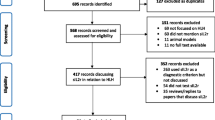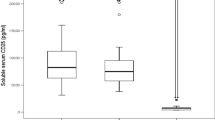Abstract
To investigate the characteristics of patients with adult-onset Still's disease (AOSD), serum cytokines and chemokines were measured to examine their associations with systemic manifestations of AOSD, especially hemophagocytic syndrome (HPS). Nineteen patients diagnosed with AOSD were enrolled. Serial serum samples were obtained from patients with AOSD in both active and inactive stages and controls. The concentrations of cytokines and chemokines, including IL-18, soluble IL-2 receptor (sIL-2R), CX3CL1, CXCL8, CXCL10, CCL2, and CCL3, were determined using enzyme-linked immunosorbent assay. Multivariate analysis was used to evaluate the correlations among serum chemokine levels, disease activity, and the clinical features of AOSD. Significantly higher serum levels of all cytokines and chemokines were observed in patients with active, untreated AOSD than in controls. The level of CX3CL1, but not other chemokines, was elevated in AOSD patients and was positively correlated with clinical activity and the levels of CRP, ferritin, IL-18, and sIL-2R. Among the 19 patients with AOSD, four patients also had HPS. Serum CX3CL1 and ferritin were significantly higher in AOSD patients with HPS than in those without HPS. The serum CX3CL1 level may be used as a clinical marker to assess the disease activity of AOSD, and high serum CX3CL1 and ferritin in patients with AOSD reflected the presence of HPS. The association between the chemokine profile and distinct clinical manifestations or various patterns of disease progression indicates that the pathogenesis of AOSD is heterogeneous.



Similar content being viewed by others
References
Pouchot J, Sampalis JS, Beaudet F, Carette S, Decary F, Salusinsky-Sternbach M et al (1991) Adult Still's disease: manifestations, disease course, and outcome in 62 patients. Medicine 70:118–136
Efthimiou P, Kontzias A, Ward CM, Ogden NS (2007) Adult-onset Still's disease: can recent advances in our understanding of its pathogenesis lead to targeted therapy? Nat Clin Pract Rheumatol 3:328–335
Schwarz-Eywill M, Heilig B, Bauer H, Breitbart A, Pezzutto A (1992) Evaluation of serum ferritin as a marker for adult Still's disease activity. Ann Rheum Dis 51:683–685
Sharma M (2010) Chemokines and their receptors: orchestrating a fine balance between health and disease. Crit Rev Biotechnol 30:1–22
Scheinberg MA, Chapira E, Fernandes ML, Hubscher O (1996) Interleukin 6: a possible marker of disease activity in adult onset Still's disease. Clin Exp Rheumatol 14:653–655
Kawashima M, Yamamura M, Taniai M, Yamauchi H, Tanimoto T, Kurimoto M et al (2001) Levels of interleukin-18 and its binding inhibitors in the blood circulation of patients with adult-onset Still's disease. Arthritis Rheum 44:550–560
Choi JH, Suh CH, Lee YM, Suh YJ, Lee SK, Kim SS et al (2003) Serum cytokine profiles in patients with adult onset Still's disease. J Rheumatol 30:2422–2427
Henter JI, Horne A, Arico M, Egeler RM, Filipovich AH, Imashuku S et al (2007) HLH-2004: diagnostic and therapeutic guidelines for hemophagocytic lymphohistiocytosis. Pediatr Blood Cancer 48:124–131
Grom AA (2003) Macrophage activation syndrome and reactive hemophagocytic lymphohistiocytosis: the same entities? Curr Opin Rheumatol 15:587–590
Larroche C, Mouthon L (2004) Pathogenesis of hemophagocytic syndrome (HPS). Autoimmun Rev 3:69–75
Wong KF, Hui PK, Chan JLC (1991) The acute lupus hemophagocytic syndrome. Ann Int Med 114:387–390
Onishi R, Namiuchi (1994) Hemophagocytic syndrome in a patient with rheumatoid arthritis. Intern Med 33:607–611
Negishi M, Kasama T, Iwabuchi H, Kanemitsu H, Ide H (2002) Autoimmune-associated hemophagocytic syndrome in a patient with rheumatoid arthritis. Clin Rheumatol 21:87–88
Yajima N, Wakabayashi K, Odai T, Isozaki T, Matsunawa M, Miwa Y et al (2008) Clinical features of hemophagocytic syndrome in patients with dermatomyositis. J Rheumatol 35:1838–1841
Coffernils M, Soupart A, Pradier O, Feremans W, Neve P, Decaux G (1992) Hyperferritinemia in adult onset Still's disease and the hemophagocytic syndrome. J Rheumatol 19:1425–1427
Hot A, Toh ML, Coppere B, Perard L, Madoux MH, Mausservey C et al (2010) Reactive hemophagocytic syndrome in adult-onset Still disease: clinical features and long-term outcome: a case-control study of 8 patients. Medicine 89:37–46
Yamaguchi M, Ohta A, Tsunematsu T, Kasukawa R, Mizushima Y, Kashiwagi H et al (1992) Preliminary criteria for classification of adult Still's disease. J Rheumatol 19:424–430
Cush JJ, Medsger TA Jr, Christy WC, Herbert DC, Cooperstein LA (1987) Adult-onset Still's disease. Clinical course and outcome. Arthritis Rheum 30:186–194
Zen M, Canova M, Campana C, Bettio S, Nalotto L, Rampudda M et al (2011) The kaleidoscope of glucorticoid effects on immune system. Autoimmun Rev 10:305–310
Hoshino T, Ohta A, Yang D, Kawamoto M, Kikuchi M, Inoue Y et al (1998) Elevated serum interleukin 6, interferon-gamma, and tumor necrosis factor-alpha levels in patients with adult Still's disease. J Rheumatol 25:396–398
Fujii T, Nojima T, Yasuoka H, Satoh S, Nakamura K, Kuwana M et al (2001) Cytokine and immunogenetic profiles in Japanese patients with adult Still's disease. Association with chronic articular disease. Rheumatology 40:1398–1404
Chen DY, Lan JL, Lin FJ, Hsieh TY (2004) Proinflammatory cytokine profiles in sera and pathological tissues of patients with active untreated adult onset Still's disease. J Rheumatol 31:2189–2198
Ruth JH, Volin MV, Haines GK 3rd, Woodruff DC, Katschke KJ Jr, Woods JM et al (2001) Fractalkine, a novel chemokine in rheumatoid arthritis and in rat adjuvant-induced arthritis. Arthritis Rheum 44:1568–1581
Matsunawa M, Isozaki T, Odai T, Yajima N, Takeuchi HT, Negishi M et al (2006) Increased serum levels of soluble fractalkine (CX3CL1) correlate with disease activity in rheumatoid vasculitis. Arthritis Rheum 54:3408–3416
Matsunawa M, Odai T, Wakabayashi K, Isozaki T, Yajima N, Miwa Y et al (2009) Elevated serum levels of soluble CX3CL1 in patients with microscopic polyangiitis. Clin Exp Rheumatol 27:72–78
Kasama T, Wakabayashi K, Sato M, Takahashi R, Isozaki T (2010) Relevance of the CX3CL1/fractalkine-CX3CR1 pathway in vasculitis and vasculopathy. Transl Res 155:20–26
Suzuki F, Nanki T, Imai T, Kikuchi H, Hirohata S, Kohsaka H et al (2005) Inhibition of CX3CL1 (fractalkine) improves experimental autoimmune myositis in SJL/J mice. J Immunol 175:6987–6996
Murphy G, Caplice N, Molloy M (2008) Fractalkine in rheumatoid arthritis: a review to date. Rheumatology 47:1446–1451
Lambotte O, Cacoub P, Costedoat N, Le Moel G, Amoura Z, Piette JC (2003) High ferritin and low glycosylated ferritin may also be a marker of excessive macrophage activation. J Rheumatol 30:1027–1028
Nakanishi K, Yoshimoto T, Tsutsui H, Okamura H (2001) Interleukin-18 regulates both Th1 and Th2 responses. Annu Rev Immunol 19:423–474
Kobayashi K, Kaneda K, Kasama T (2001) Immunopathogenesis of delayed-type hypersensitivity. Microsc Res Tech 53:241–245
Chen DY, Lan JL, Lin FJ, Hsieh TY, Wen MC (2004) Predominance of Th1 cytokine in peripheral blood and pathological tissues of patients with active untreated adult onset Still's disease. Ann Rheum Dis 63:1300–1306
Hildesheim A, Schiffman MH, Tsukui T, Swanson CA, Lucci J 3rd, Scott DR et al (1997) Immune activation in cervical neoplasia: cross-sectional association between plasma soluble interleukin 2 receptor levels and disease. Cancer Epidemiol Biomarkers Prev 6:807–813
Fraticelli P, Sironi M, Bianchi G, D'Ambrosio D, Albanesi C, Stoppacciaro A et al (2001) Fractalkine (CX3CL1) as an amplification circuit of polarized Th1 responses. J Clin Invest 107:1173–1181
Nakahara H, Mima T, Yoshio-Hoshino N, Matsushita M, Hashimoto J, Nishimoto N (2009) A case report of a patient with refractory adult-onset Still's disease who was successfully treated with tocilizumab over 6 years. Mod Rheumatol 19:69–72
De Bandt M, Saint-Marcoux B (2009) Tocilizumab for multirefractory adult-onset Still's disease. Ann Rheum Dis 68:153–154
Perdan-Pirkmajer K, Praprotnik S, Tomsic M (2010) A case of refractory adult-onset Still's disease successfully controlled with tocilizumab and a review of the literature. Clin Rheumatol 29:1465–1467
Ancuta P, Moses A, Gabuzda D (2004) Transendothelial migration of CD16+ monocytes in response to fractalkine under constitutive and inflammatory conditions. Immunobiology 209:11–20
Efthimiou P, Georgy S (2006) Pathogenesis and management of adult-onset Still's disease. Semin Arthritis Rheum 36:144–152
Emmenegger U, Reimers A, Frey U, Fux C, Bihl F, Semela D et al (2002) Reactive macrophage activation syndrome: a simple screening strategy and its potential in early treatment initiation. Swiss Med Wkly 132:230–236
Acknowledgments
This study was supported in part by a grant from the Ministry of Health, Labor, and Welfare of Japan. We would like to thank Mrs. Hiroko T. Takeuchi and Kyoko Nohtomi for their help with the experiments.
Disclosures
None.
Author information
Authors and Affiliations
Corresponding author
Rights and permissions
About this article
Cite this article
Kasama, T., Furuya, H., Yanai, R. et al. Correlation of serum CX3CL1 level with disease activity in adult-onset Still's disease and significant involvement in hemophagocytic syndrome. Clin Rheumatol 31, 853–860 (2012). https://doi.org/10.1007/s10067-012-1952-1
Received:
Revised:
Accepted:
Published:
Issue Date:
DOI: https://doi.org/10.1007/s10067-012-1952-1




